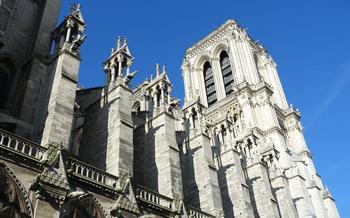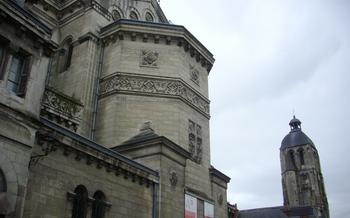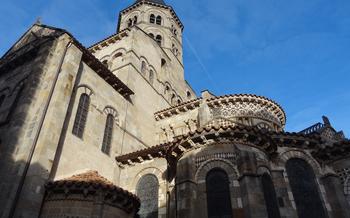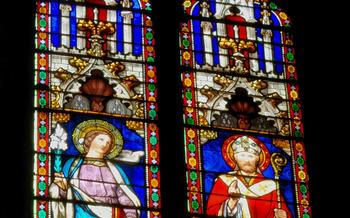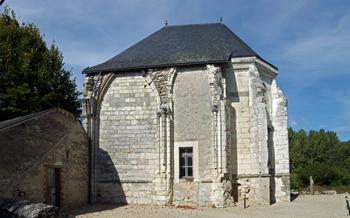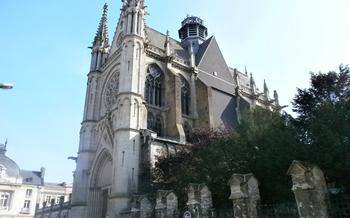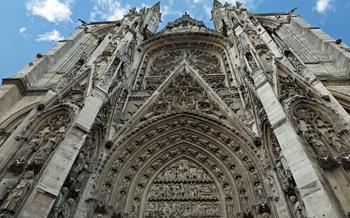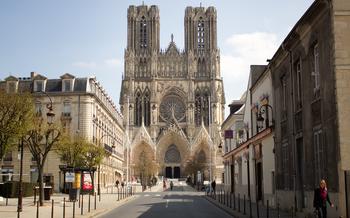
Église Sainte Jeanne d'Arc
- A Monument to Faith and Resilience: The History of Église Sainte Jeanne d'Arc
- Architecture and Design
- Stained Glass Windows
- Altarpiece and Statues
- Relics and Treasury
- Chapels and Side Altars
- Bells and Clock Tower
- Organ and Music
- Local Pilgrimages and Celebrations
- Visiting Hours and Practical Information
- Guided Tours and Audio Guides
- Nearby Attractions and Points of Interest
- Photography and Social Media
- Accessibility for Disabled Visitors:
- Insider Tip:
A Monument to Faith and Resilience: The History of Église Sainte Jeanne d'Arc
In the heart of Clermont-Ferrand, France, stands the Église Sainte Jeanne d'Arc, a testament to the city's rich history and enduring faith. Its construction began in 1934, amidst the aftermath of World War I, as a symbol of hope and renewal. Inspired by the Gothic Revival style, this church embodies the architectural spirit of the Middle Ages, blending traditional elements with modern construction techniques. The decision to build the church was driven by a desire to honor Joan of Arc, the revered French heroine who played a pivotal role in the Hundred Years' War. Today, the Église Sainte Jeanne d'Arc serves as a vibrant spiritual center for the local community, hosting regular services, celebrations, and pilgrimages.
Architecture and Design
The Église Sainte Jeanne d'Arc stands as a testament to Gothic architectural prowess. Its exterior façade showcases intricate carvings, pointed arches, and towering buttresses that lend a sense of grandeur to the structure. The church's interior is equally captivating, with soaring vaults, ribbed arches, and stained-glass windows that bathe the space in a celestial glow. The nave and aisles are separated by rows of slender columns, creating a sense of spaciousness and verticality. The ribbed vaults, adorned with intricate keystones, converge at the center of the ceiling, drawing the eye upward and instilling a sense of awe.
Stained Glass Windows
The Église Sainte Jeanne d'Arc is renowned for its exquisite stained glass windows, which illuminate the interior with vibrant colors and intricate designs. Created by renowned 19th-century master glassmakers, these windows depict biblical scenes and religious figures with remarkable artistry and detail. The thematic representations range from the life of Christ and the Virgin Mary to scenes from the Old Testament and the lives of various saints. Each window tells a story, inviting viewers to contemplate the deeper meanings and symbolism behind the imagery.
The windows' artistic value lies in their diverse styles and techniques. Some feature vibrant, naturalistic colors, while others employ more subdued tones to create a sense of mystery and reverence. The glassmakers skillfully used light and shadow to enhance the narrative elements and create a sense of depth and movement within each scene. The windows serve not only as decorative elements but also as powerful tools for teaching and inspiration, conveying religious messages and moral lessons to the faithful.
Altarpiece and Statues
The centerpiece of the Église Sainte Jeanne d'Arc is its awe-inspiring altarpiece, a magnificent work of art and a testament to the church's rich history. The focal point of the altarpiece is a captivating statue of Joan of Arc, the patron saint of France. Joan is depicted in full armor, radiating strength and determination, holding a sword in one hand and a banner in the other. The intricate details of her armor, the flowing folds of her banner, and the serene expression on her face create a mesmerizing visual experience.
The altarpiece's symbolism is as profound as its artistry. Joan of Arc, a symbol of courage and unwavering faith, stands tall amidst a celestial realm, flanked by angels and saints. The vivid colors and intricate carvings convey the heavenly atmosphere and the divine presence that permeates the church. The altarpiece serves as a reminder of Joan's unwavering devotion and her role as a messenger of God, inspiring visitors to reflect on their own faith and determination in the face of adversity.
In addition to the main altarpiece, the church boasts several notable statues and sculptures. These works of art depict various religious figures and scenes, each adding to the spiritual ambiance of the church. From the serene figure of the Virgin Mary to the intricate carvings of saints and apostles, these statues not only enhance the visual appeal of the church but also provide a deeper connection to the stories and teachings of Christianity.
Relics and Treasury
Enriching the sacred ambiance of the Église Sainte Jeanne d'Arc is the presence of a small but significant treasury. Within its secure confines, a collection of precious artifacts holds deep historical and religious significance for the church and the local community. Among these treasures, one can find relics, remnants of the lives of saints, martyrs, or significant religious figures, which are revered for their connection to the divine. These relics serve as tangible reminders of the church's enduring faith and the lives of those who dedicated themselves to serving God.
The treasury also houses a collection of exquisitely crafted religious objects, each imbued with symbolic and artistic value. From ornate chalices and ciboria used in the celebration of the Eucharist to intricately designed monstrances that hold the consecrated host, these objects bear witness to the artistry and devotion of the church's past artisans. Whether it's the shimmering brilliance of gold and silver or the delicate craftsmanship of intricate carvings, these treasures reflect the deep reverence and care with which they were created.
Access to the treasury is typically restricted, but visitors may be granted a glimpse of its wonders upon request. Discovering the hidden treasures of the Église Sainte Jeanne d'Arc is like embarking on a journey through time, connecting with the stories of faith, devotion, and craftsmanship that have shaped the church's legacy.
Chapels and Side Altars
Within the Église Sainte Jeanne d'Arc, visitors can explore several chapels and side altars that add to the spiritual and artistic richness of the church. These spaces serve as places of prayer, devotion, and contemplation for the local community and pilgrims alike. Each chapel or altar has its own unique dedication, theme, or artwork, contributing to the diverse tapestry of the church's interior.
One notable chapel is the Chapelle du Sacré-Cœur, dedicated to the Sacred Heart of Jesus. This chapel features intricate stained glass windows depicting scenes from the life of Christ and the saints. The Chapelle Notre-Dame de Lourdes, on the other hand, is dedicated to the Virgin Mary and houses a replica of the grotto of Lourdes, a popular pilgrimage site in France.
In addition to these chapels, the church also boasts several side altars, each with its own distinct design and iconography. These altars are dedicated to various saints and offer spaces for private prayer and reflection. Visitors can admire the delicate carvings, sculptures, and paintings that adorn these altars, each telling a story of faith and devotion.
The chapels and side altars at the Église Sainte Jeanne d'Arc offer visitors a glimpse into the rich spiritual and artistic heritage of the church. These spaces invite contemplation, prayer, and a deeper connection with the sacred. Whether seeking solace, inspiration, or a deeper understanding of the Christian faith, visitors will find much to appreciate and explore within these sacred spaces.
Bells and Clock Tower
The Église Sainte Jeanne d'Arc stands tall, its clock tower piercing the sky like a beacon of time. Built in the 17th century, this tower houses a remarkable set of bells that have tolled for centuries, marking the passage of time and echoing their melodious chimes across the city. The largest of these bells, aptly named "Marie," weighs in at an impressive 1,500 kilograms and reverberates with a deep, sonorous tone. Its counterpart, "Gabrielle," is slightly smaller but no less significant, its clear and resonant sound complementing Marie's majestic peal.
The bells of the Église Sainte Jeanne d'Arc are not merely timekeepers; they are integral to the religious and cultural fabric of the community. Their harmonious chorus signals the start of Mass, calls the faithful to prayer, and commemorates special occasions with a celebratory peal. The tower's clock, with its intricate mechanism and delicate hands, adds a touch of elegance to the church's façade and serves as a reminder of the cyclical nature of life.
As the sun sets and twilight casts long shadows across the city, the bells of the Église Sainte Jeanne d'Arc continue to ring, their melody echoing through the quiet streets. They serve as a soothing lullaby for the weary and a reminder of the enduring presence of faith in the heart of Clermont-Ferrand.
Organ and Music
The Église Sainte Jeanne d'Arc boasts a magnificent organ that adds to its grandeur and spiritual ambiance. Installed in the early 20th century, this impressive instrument features an intricate combination of pipes, keyboards, and pedals, creating a rich and resonant sound that fills the sacred space. The organ's history is closely intertwined with the church's musical traditions and liturgical services.
Throughout the centuries, talented organists have graced the console, leading congregations in hymns, accompanying choirs, and performing awe-inspiring recitals. The church's acoustics, coupled with the organ's versatility, create a harmonious environment for sacred music to flourish. Notable organists have performed here, leaving an indelible mark on the musical legacy of the church.
Local Pilgrimages and Celebrations
The Église Sainte Jeanne d'Arc holds a significant place as a pilgrimage site for the local community. Throughout the year, various religious processions and pilgrimages take place, attracting a multitude of devout attendees. One of the most notable events is the annual pilgrimage in honor of Saint Joan of Arc, the church's namesake. During this special occasion, pilgrims from near and far gather to pay homage to the saint and seek her blessings.
The church also plays a central role in celebrating important religious festivals. During Easter and Christmas, grand masses and processions fill the church with joyous melodies and vibrant decorations. These celebrations serve as opportunities for the community to come together, reaffirm their faith, and share in the spirit of unity and devotion. The participation and enthusiasm of the local faithful during these events further reinforce the church's profound connection with the community it serves.
Visiting Hours and Practical Information
Église Sainte Jeanne d'Arc welcomes visitors from all over the world with open arms. To ensure a peaceful and respectful visit, please take note of the following practical information:
-
Visiting Hours: The church is open to the public daily from 9:00 AM to 5:00 PM. Please note that these hours may vary during religious services or special events, so it's advisable to check in advance.
-
Admission: Admission to the church is free of charge. However, donations are gratefully accepted to support the maintenance and preservation of this sacred space.
-
Dress Code: While there is no strict dress code, visitors are encouraged to dress modestly and respectfully, in accordance with the religious nature of the site.
-
Accessibility: Église Sainte Jeanne d'Arc is committed to accessibility for all visitors. Wheelchair ramps and accessible restrooms are available for those in need. Should you require any assistance or have specific accessibility concerns, please do not hesitate to reach out to the church staff, who will be more than happy to accommodate your needs.
Guided Tours and Audio Guides
For those seeking a more immersive experience, guided tours of the Église Sainte Jeanne d'Arc are available. These tours provide an in-depth look into the church's history, architecture, and religious significance. Knowledgeable guides share fascinating insights and anecdotes, bringing the church's rich past to life. Tours are conducted in several languages, including English and French, ensuring that international visitors can fully appreciate the church's beauty and grandeur.
Audio guides are also available for self-guided exploration. These audio devices offer recorded commentary, allowing visitors to learn about the church's highlights at their own pace. With detailed descriptions and historical context, the audio guides enhance the visitor experience and provide a deeper understanding of the church's significance. Advance booking for guided tours or audio guides is recommended, especially during peak tourist seasons, to avoid disappointment.
Nearby Attractions and Points of Interest
Beyond its religious significance, the Église Sainte Jeanne d'Arc is surrounded by a wealth of cultural and historical attractions that visitors can explore.
A short walk from the church, the Musée d'Art Roger-Quilliot showcases an impressive collection of modern and contemporary art, including works by Picasso, Matisse, and Chagall.
For a glimpse into local history, the Musée du Ranquet tells the story of the city's past through exhibits on archeology, ethnography, and the region's traditions.
Nature enthusiasts can stroll through the nearby Jardin Lecoq, a beautiful botanical garden featuring diverse plant species and serene walking paths.
To savor the region's culinary delights, visitors can head to the Marché Saint-Pierre, a vibrant market offering fresh produce, artisanal cheeses, and local specialties.
For a leisurely lunch or dinner, the surrounding streets are lined with charming cafes and restaurants serving traditional French cuisine.
Photography and Social Media
The Église Sainte Jeanne d'Arc welcomes photography and encourages visitors to capture the beauty of its sacred spaces. However, respectful photography is essential, ensuring that religious artifacts and services are not disturbed. Please avoid using flash photography, and always ask permission before photographing individuals.
Sharing your experiences on social media is a wonderful way to spread the word about this magnificent church. Tag your photos with #eglise_sainte_jeanne_darc and #clermontferrand to connect with other visitors and share your love of this sacred site.
Accessibility for Disabled Visitors:
The Église Sainte Jeanne d'Arc recognizes the importance of inclusivity and strives to ensure that all visitors, regardless of their physical abilities, can fully appreciate the church's beauty and spiritual atmosphere. To this end, the church has implemented several accessibility features to accommodate disabled visitors.
Ramps and elevators provide easy access to the church's interior, eliminating barriers for those with limited mobility. Wheelchair users and individuals with mobility impairments can comfortably navigate the church's main level and explore the various chapels and side altars without encountering obstacles.
Designated seating areas within the church are reserved for disabled visitors, allowing them to participate in services and events with ease and comfort. These areas are strategically located to provide clear sightlines to the altar and the intricate details of the interior.
Upon request, the church staff and volunteers are more than willing to provide assistance to disabled visitors. They can offer guidance in navigating the church's spaces, provide information about the history and significance of various features, and assist with any special needs or requests.
With its commitment to accessibility, the Église Sainte Jeanne d'Arc ensures that everyone has the opportunity to experience the spiritual and cultural richness of this magnificent edifice, regardless of their physical limitations.
Insider Tip:
To fully immerse yourself in the tranquility of the Église Sainte Jeanne d'Arc, consider visiting early in the morning or late in the afternoon when the crowds are fewer. This will allow you to savor the serene atmosphere of the church and appreciate its intricate details without distractions. Additionally, if you're fortunate enough to visit during a special event or service, such as a traditional French mass or a choir performance, you'll have the opportunity to witness the church come alive with vibrant energy and devotion. Don't forget to pay attention to the small, often overlooked features of the church, such as the intricate carvings on the choir stalls or the hidden symbolism depicted in the stained glass windows. These details add depth and richness to the overall experience of visiting the Église Sainte Jeanne d'Arc. Finally, if you're curious about local customs and traditions related to the church, feel free to engage in polite conversation with the friendly locals or church staff. They'll be delighted to share their insights and stories, enhancing your understanding of the church's significance within the community.
